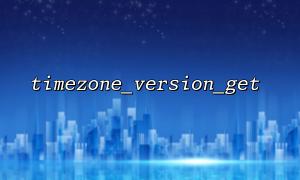In PHP projects, timezone management is crucial, especially when dealing with date and time processing. PHP offers several functions and classes for handling timezones, one of which is the timezone_version_get function, used to get the timezone database version. This function is especially useful in certain scenarios, particularly when dealing with timezone data updates and management, as it allows developers to determine the version of the timezone database currently in use by the system.
This article will provide a detailed explanation on how to correctly use the timezone_version_get function in PHP projects, including the basic concept of the function, its invocation, and common application scenarios.
The timezone_version_get function in PHP is used to retrieve the current system's timezone database version. The timezone database is maintained by IANA (Internet Assigned Numbers Authority) and contains timezone data for locations around the world. If your PHP project involves handling dates across timezones, it is crucial to ensure that the timezone database is up to date. The timezone_version_get function helps you check which version of the timezone database is currently being used.
The function prototype is as follows:
<span><span><span class="hljs-keyword">string</span></span><span> </span><span><span class="hljs-title function_ invoke__">timezone_version_get</span></span><span> ( </span><span><span class="hljs-keyword">void</span></span><span> )
</span></span>The function takes no parameters and returns a string representing the version number of the current timezone database when invoked.
Using timezone_version_get in PHP is very simple. You only need to call the function directly in your code to get the version of the current timezone database.
Example Code:
<span><span><span class="hljs-meta"><?php</span></span><span>
</span><span><span class="hljs-comment">// Get the current timezone database version</span></span><span>
</span><span><span class="hljs-variable">$version</span></span><span> = </span><span><span class="hljs-title function_ invoke__">timezone_version_get</span></span><span>();
<p></span>// Output the timezone database version<br>
echo "Current timezone database version: " . $version;<br>
?><br>
</span>Output:
<span><span>Current timezone database version: 2022a
</span></span>As shown in the example above, the timezone_version_get function returns the version number of the timezone database. In this case, the returned value is "2022a", which indicates that the system is using the IANA timezone database version 2022a.
The main purpose of the timezone_version_get function is to help developers determine the version of the timezone database in use. This function becomes especially important in the following scenarios:
Check if the timezone database is outdated: Timezone data is updated periodically, especially when daylight saving time rules change in certain countries or regions. IANA releases new versions of the timezone database in such cases. If your PHP project relies on accurate date-time data, it's a good practice to check if the timezone version is up to date.
Diagnose timezone-related issues: When handling dates and times, timezone accuracy is critical. If you encounter errors in cross-timezone calculations, checking the timezone database version may help pinpoint the issue's source.
Cross-platform compatibility: Different operating systems and PHP versions may use different versions of the timezone database. By using the timezone_version_get function, you can ensure that the timezone data is consistent across different environments.
Automatic updates and maintenance: If your project requires automated timezone data management, you can combine the timezone_version_get function with other timezone database update tools to ensure that the system's timezone data is always up to date.
Version dependencies: PHP's timezone functions rely on the IANA timezone database, so they depend on the installed version of the database. If the system is using an outdated timezone version, you may encounter errors in date calculations or issues with daylight saving time.
PHP and operating system relationship: Sometimes the timezone database version used by PHP may differ from that of the operating system. While PHP has built-in timezone functionality, in certain cases, the operating system's timezone data may not have been updated in a timely manner, leading to inaccuracies in the timezone information PHP uses.
Updating the timezone database: If you discover that the timezone version is outdated when using the timezone_version_get function, you can update the timezone database through your operating system's package manager (e.g., apt-get, yum, etc.) or by updating the PHP pecl extension.
The timezone_version_get function is a simple yet useful tool, particularly when managing or checking the version of the timezone database. By using this function, developers can easily determine the current timezone database version of their system and take necessary actions to ensure the accuracy and timeliness of the timezone data. Proper use of the timezone_version_get function in PHP projects can enhance the reliability of cross-timezone operations and prevent potential timezone-related calculation errors.




